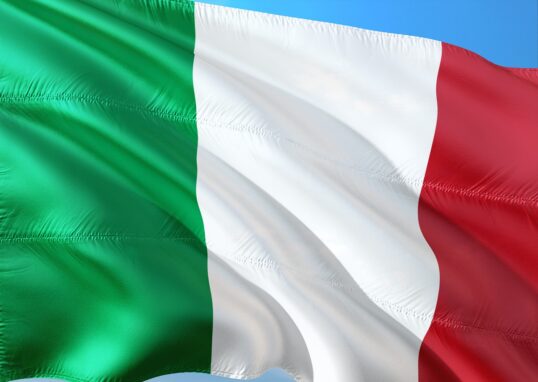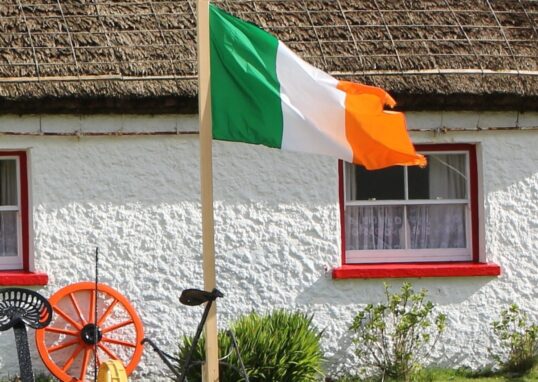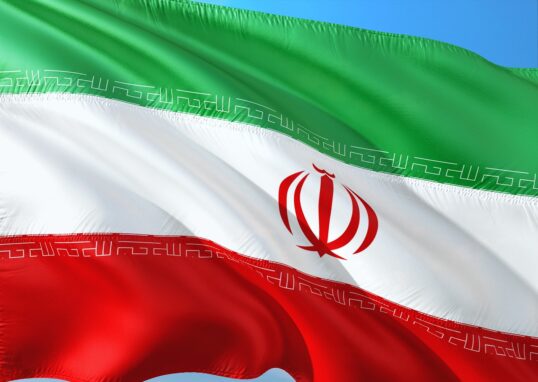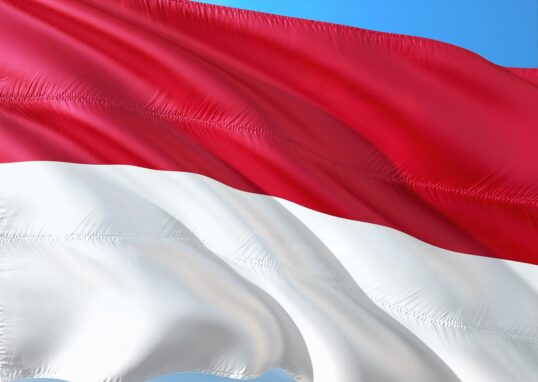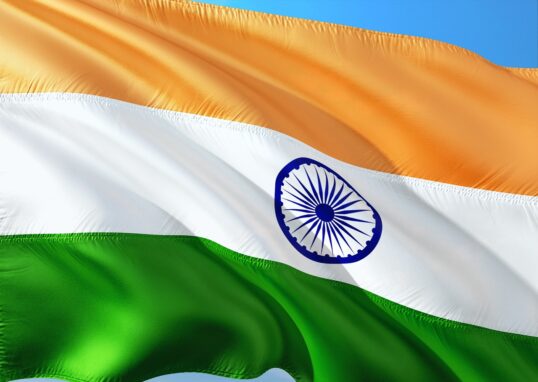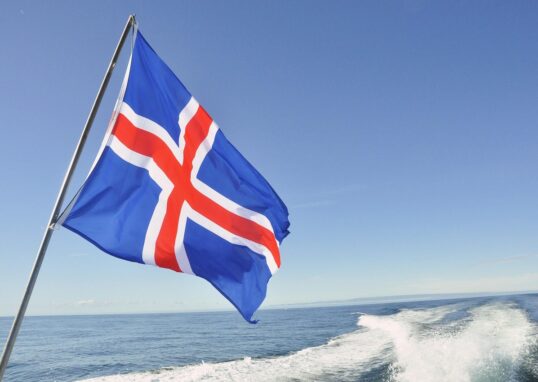
🌅 Cyprus – The Island of Beauty and History
Cyprus is a small island nation in the eastern Mediterranean Sea. It is the third-largest island in the Mediterranean, after Sicily and Sardinia. The country enjoys beautiful beaches, ancient ruins, charming villages, and a warm, sunny climate almost throughout the year. Cyprus is situated at the meeting point of Europe, Asia, and Africa. Because of this, it boasts a very long and interesting history that includes Greek, Roman, Byzantine, Ottoman, and British elements. Today, Cyprus is a modern and peaceful country in which rich traditions are combined with a high quality of life. Greek and Turkish are the official languages, while English is also widely spoken everywhere. The main division of the island is into two main parts:
- The Republic of Cyprus, occupying the southern part.
- Northern Cyprus is administered by Turkish Cypriots since 1974.
Despite the political division, this island remains one of the favorite travel destinations, cherished for its hospitality, food, and sunshine.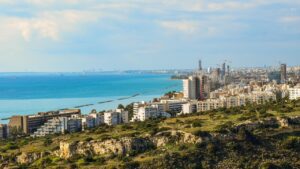
Geography and Climate
Cyprus is situated south of Turkey, west of Syria and Lebanon, northwest of Israel, and north of Egypt. Its strategic location has made it an important center for trade and culture for thousands of years. The island has an area of approximately 9,250 square kilometers. It has two significant mountain ranges-the Troodos Mountains in the center and southwest and the Kyrenia Range in the north. The highest peak is Mount Olympus, standing at 1,952 meters above sea level. Between the two mountain ranges lies a wide plain, called the Mesaoria Plain, which is the chief agricultural region. Along the coastline of the island are sandy beaches, rocky cliffs, and small bays. The Mediterranean climate is characterized by hot, dry summers and mild, rainy winters. In summer, the average can rise up to 35°C, while in winter, it is about 15°C. Because of its pleasant weather conditions, Cyprus is a destination to travel to any time of the year. Visitors come for beaches, mountain hikes, or even skiing in the Troodos Mountains during winter.
A Journey Through History
Cyprus has one of the oldest histories in the world. Archaeological sites show that people have lived on the island since around 10,000 BCE.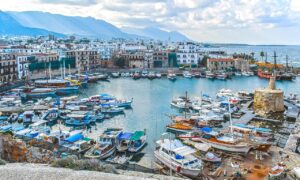
Ancient Times
In ancient times, Cyprus was famous for its copper mines. In fact, the word “copper” comes from the Latin cuprum, a name meaning metal from Cyprus. The island traded copper and pottery with Egypt, Greece, and other civilizations. The Mycenaean Greeks settled here about 1400 BCE, bringing their language and culture. Later, the island became part of several empires: Assyrian, Egyptian, and Persian.
Greek and Roman Era
Alexander the Great conquered Cyprus in 333 BCE. Following his death, the island came into the possession of the Ptolemaic Kingdom of Egypt, whose rulers spoke Greek. Later, Cyprus was conquered by the Romans in 58 BCE. Cyprus became an early center of Christianity during Roman times. The Apostles Paul and Barnabas visited the island to spread the Christian faith.
Byzantine and Medieval Period
Following the fall of the Roman Empire, Cyprus came under the Byzantine Empire. Many of the churches and monasteries date back to this period and are still standing today. In 1191, King Richard the Lionheart of England conquered the island during one of the crusades. Later on, Cyprus was ruled by the Lusignan dynasty (a French noble family) and then the Venetians who fortified the cities against Ottoman attacks.
Ottoman and British Rule
The Ottoman Empire took over in 1571 and ruled Cyprus for more than 300 years. Many mosques, baths, and traditional houses from that period remain. In 1878, Britain took administrative control of the island, and Cyprus became officially a British colony in 1925.
Modern Era
Cyprus became independent in 1960. However, inter-ethnic tension between Greek Cypriots and Turkish Cypriots led to outbreak of violence in 1974. The island was then divided into two parts: the southern part consists of the Greek Cypriot region, while the northern part is Turkish Cypriot, following a Turkish military intervention. Today both sides are peaceful and open to visitors. The capital, Nicosia (Lefkosia), remains the last divided capital in Europe.
Major Cities and Regions
Cyprus has many charming towns and cities, each with its own character and attractions.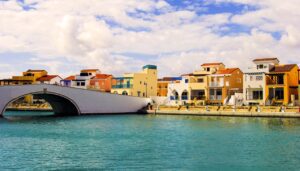
Nicosia (Lefkosia)
Nicosia is the capital and cultural heart of Cyprus, and it is located right at the center of the island. What is unique about Nicosia is that it is divided-the southern half belongs to the Republic of Cyprus, while the northern half is part of Turkish Cyprus. The city is encircled with 16th-century Venetian walls that are in very good condition. The Old Town has narrow streets, small shops, and beautiful churches and mosques. Key attractions include:
- Cyprus Museum, which displays artifacts from the Neolithic and Roman periods.
- Ledra Street, a lively pedestrian area with shops and cafés.
- Selimiye Mosque (former St. Sophia Cathedral), a strikingly beautiful Gothic building. Nicosia is a perfect blend of history, culture, and modern life.
Limassol (Lemesos)
Limassol is the second-largest city and one of the island’s busiest ports; it faces south and is known for its seafront promenade, luxury hotels, and vibrant nightlife. Narrow cobblestone streets full of cafes and boutiques characterize the Old Town of Limassol. The Limassol Castle in the vicinity of the harbor today houses the Cyprus Medieval Museum. Local attractions include:
- Kourion Archaeological Site, which includes ancient Greek-Roman ruins and a big open-air theater overlooking the sea.
- Kolossi Castle is a medieval fortress built by the Crusaders.
Colorful events held in Limassol include the Carnival Festival and the Wine Festival, which mark the winemaking traditions of this city.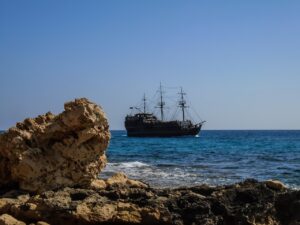
Larnaca (Larnaka)
Larnaca is an easygoing coastal city with relaxed charm. It’s also home to Cyprus’s main international airport and therefore the first port of call for many visitors. The Finikoudes Promenade in this city is lined with palm trees, restaurants, and shops. One of the most famous landmarks is the Church of Saint Lazarus, built in the 9th century. Nearby attractions include:
- Larnaca Salt Lake, a habitat for flamingos during winter.
- Hala Sultan Tekke Mosque is one of the most important Islamic sites on the island.
- Choirokoitia, a Neolithic village and UNESCO World Heritage Site.
Paphos (Pafos)
Paphos is situated on the southwest coast and is steeped in mythology and archaeology: it is supposedly the birthplace of Aphrodite, the Greek goddess of love, from the sea. The Paphos Archaeological Park is a UNESCO World Heritage Site, full of Roman villas, mosaics, and tombs. The Tombs of the Kings, carved into the solid rock, date back to the 4th century BCE. Paphos’ castle, situated at the harbour, was originally a Byzantine fort, rebuilt by the Ottomans. Close by is Petra tou Romiou, better known as Aphrodite’s Rock, one of Cyprus’s most photographed places. Paphos combines history, mythology, and beach life in a single beautiful setting.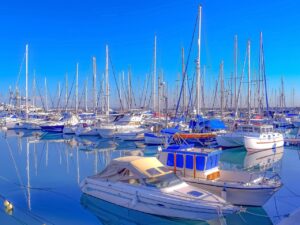
Ayia Napa and Protaras
Situated on the southeastern coast, Ayia Napa and Protaras are famous for their crystal-clear waters and golden beaches. Of these, the best known are Nissi Beach and Fig Tree Bay. These areas are ideal for swimming, snorkeling, and water sports. Ayia Napa is also known for its nightlife, thanks to the clubs and bars that attract young travelers. The center of the town boasts the famous Ayia Napa Monastery, a witness to the quiet past of this area. Protaras, situated just north of Ayia Napa, is much quieter and ideal for families with its charming seafront pathways, small restaurants, and scenic viewpoints like the Cape Greco National Park.
Culture and People
Cypriots are renowned for their hospitable natures and close-knit communities. Family life is sacred, and visitors will always be greeted with courtesy and warm hospitality.
Language and Religion
Greek is the dominating language in the south, while Turkish is spoken in the north, but English can be encountered almost everywhere. The majority of the people in the south are Greek Orthodox Christians, whereas the majority in the north believe in Islam. Religious events and festivals play an important role in daily life.
Festivals and Traditions
Cyprus celebrates religious and cultural festivals throughout the year.
- Easter is the biggest celebration in Greek Cyprus, marked with church services, fireworks, and family feasts.
- Among the unique Cypriot holidays is Kataklysmos, or the Festival of the Flood, held in coastal towns, which celebrates the link between people and the sea.
- Another favorite is the Limassol Wine Festival, where locals and tourists alike enjoy wine, food, and music.

Cuisine
Cypriot cuisine is a mixture of Greek, Turkish, and Middle Eastern flavors. Meals often include grilled meats, fresh vegetables, olive oil, and cheese. Popular dishes include:
- Halloumi: a semi-hard cheese, often grilled or fried. Souvlaki, skewered meat, grilled and served with pita bread.
- Kleftiko, slow-cooked lamb marinated in herbs.
- Meze: a selection of small dishes, usually served together like hummus, olives, and dips. Cyprus also produces excellent wines, especially from the Troodos mountain region.
Natural Beauty and Outdoor Adventures
There is much more to Cyprus than beaches. It also has mountains, forests, waterfalls, and picturesque hiking trails.
Troodos Mountains
Much of the centre of Cyprus is taken up by the Troodos Mountains, which are replete with pine forests, monasteries and villages. In winter, Mount Olympus becomes a small ski resort, making Cyprus one of the few countries in the world where you can ski and swim on the same day! One of the most famous religious sites is Kykkos Monastery, high in the mountains, which houses priceless icons and ancient manuscripts.
Akamas Peninsula
The Akamas Peninsula National Park is a protected area of wild beauty in the northwest. It has gorges, beaches, and rare wildlife. In this place, one should definitely visit the Avakas Gorge and Lara Beach, known for turtle nesting.
Cape Greco
The Cape Greco National Forest Park, located at the island’s most southeastern tip, is famous for its cliffs, sea caves, and views that take your breath away. It is a favorite spot for hiking, diving, and photography.
Economy and Modern Life
Cyprus has a high-income economy, based on tourism, services, shipping, and real estate. The country is a European Union state that has started using the euro (€) as its official currency. The service industry, from which finance, education, and healthcare stem, has become so important, yet tourism remains the most significant. Millions of visitors arrive each year, attracted by the sun, culture, and friendly people. Cities on the island are modern with excellent infrastructure, universities, hospitals, and shopping centers. Cyprus, despite development, has preserved its traditional life and historical character.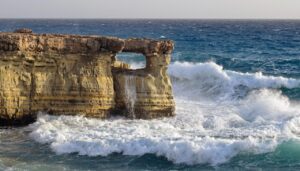
Surrounding Areas and Regional Connections
Its position makes Cyprus a gateway to so many nearby destinations.
Greece
To the northwest, Greece shares close cultural and historical ties with Cyprus. Many travelers visit both countries to enjoy this shared heritage.
Turkey
To the north is Turkey, only about 75 kilometres away. Regular flights and ferries link the two countries. Turkish Cypriot culture has close links with Anatolia.
Lebanon and Israel
To the east, Lebanon and Israel are close enough for short flights and many travelers from Cyprus take weekend trips to Beirut or Tel Aviv.
Egypt
To the south lies Egypt, just a few hours away by air. Cyprus enjoys strong trade and tourism relations with Egypt, and there are often cruise ships making their way from Limassol to Alexandria.
Tourism and Travel Tips
Cyprus is hospitable to travelers from every part of the world. The safety of its environment, combined with friendly people and modern services, makes it an ideal destination for families or solo travelers alike.
Getting There
The main international airports in Cyprus are Larnaca International Airport and Paphos International Airport. Both receive regular flights from Europe, the Middle East, and beyond.
Getting Around
The island has an excellent road network, and the best way to explore it is by renting a car. Note that driving is on the left side, a legacy of British rule. Buses and taxis are also available everywhere.
Accommodation
From luxury resorts and boutique hotels to family-run guesthouses and beachside villas, Cyprus has a wide range of accommodation options.
Best Time to Visit
The peak tourist time in Cyprus is in spring-April to June-and autumn-September to November. The weather is warm, yet the crowds are smaller.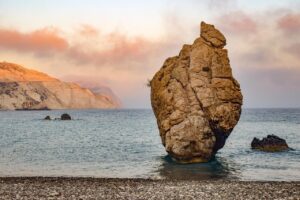
Conclusion
Cyprus is truly a land of contrasts: ancient ruins abutted by modern life, mountains rising above beaches, Greek and Turkish cultures blending in harmony. Its natural beauty, the sun, and very friendly people make it one of the most attractive destinations in Europe and the Mediterranean. From the myth of Aphrodite to the bustling streets of Limassol, from the tranquil oases of Troodos to the pulsating beaches of Ayia Napa, every inch of Cyprus has a story to tell. Whether it is history, relaxation, or adventure, Cyprus will capture your heart and leave you with lasting memories. It is not just a country, but an experience – a timeless jewel of the Mediterranean, shining with beauty, warmth, and life.


